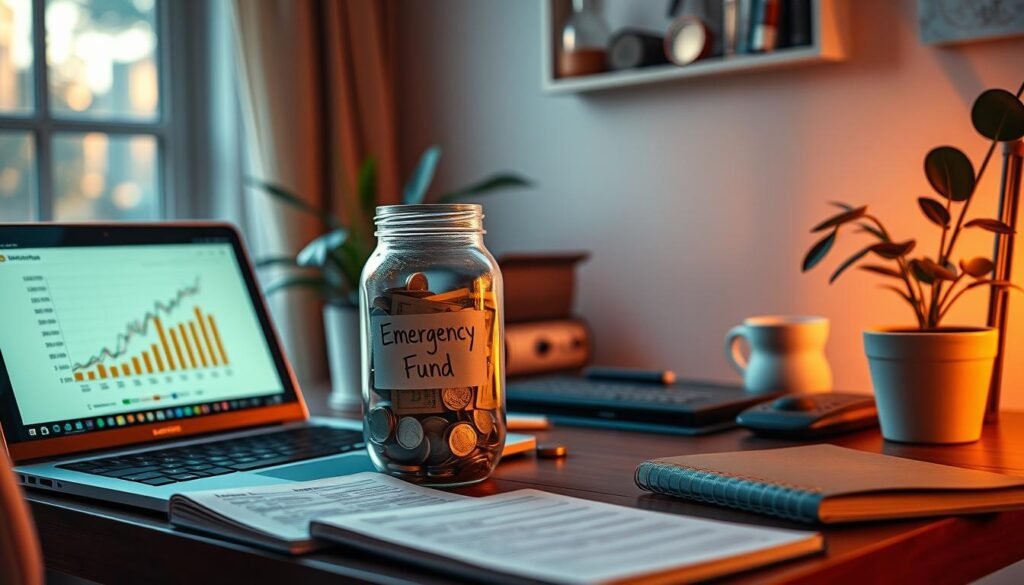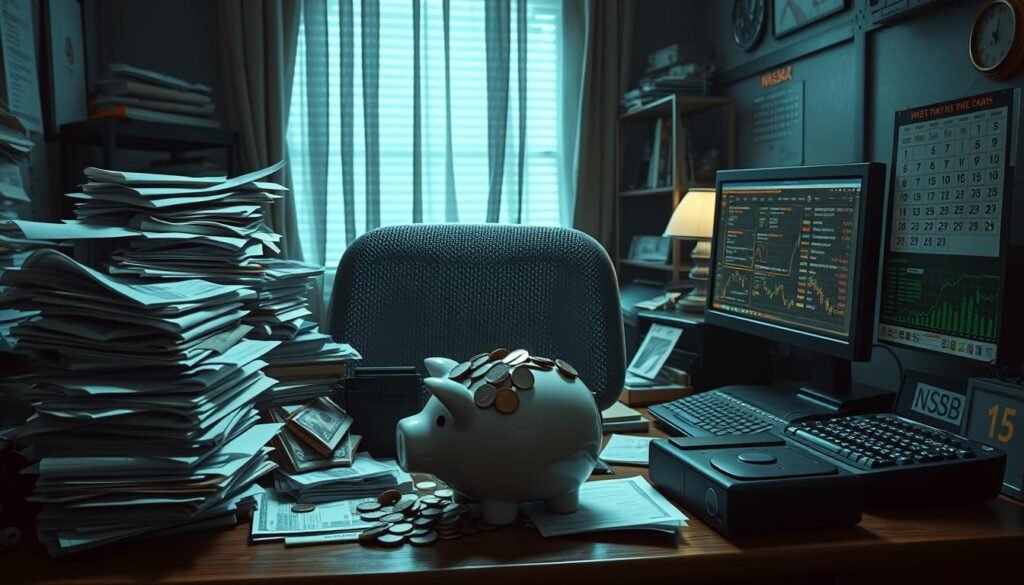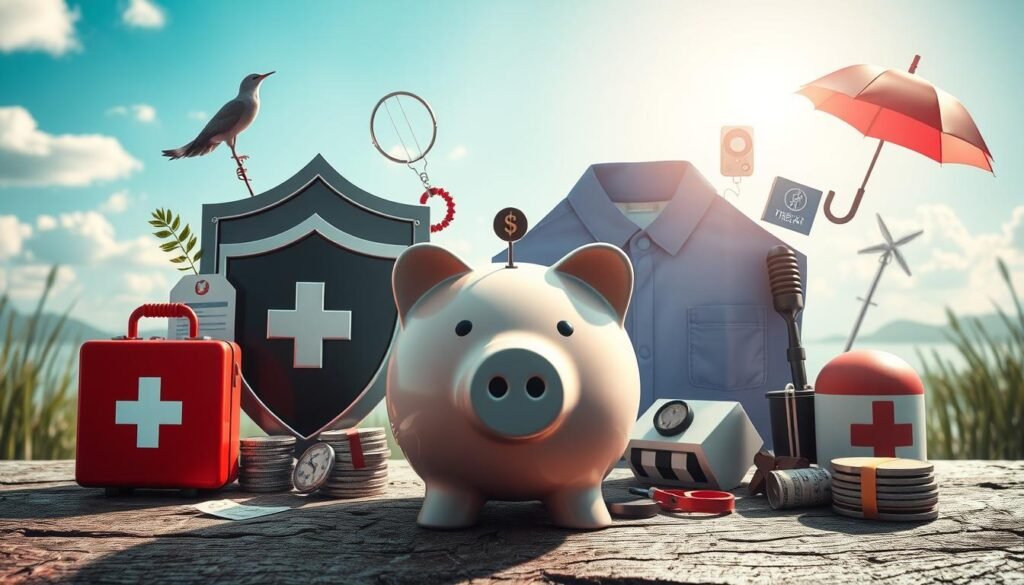Did you know nearly 60% of Americans can’t handle a $1,000 unexpected expense? In today’s world, having an emergency fund is more important than ever. You might wonder how to create a fund that protects you from job loss, health emergencies, and other surprises. It’s key for lasting financial stability.
Having a well-funded emergency savings account keeps you calm in tough times. It also prepares you for any unexpected challenges life may bring.
Key Takeaways (How to Build an Emergency Fund)
- Nearly 60% of Americans can’t handle a $1,000 emergency expense.
- An emergency fund ensures financial stability during unexpected events.
- Preparation is key to maintaining peace of mind.
- Emergency savings help protect against job loss and health emergencies.
- A well-structured financial safety net reduces stress in challenging times.
Understanding the Importance of an Emergency Fund
An emergency fund is like a safety net. It helps you deal with life’s surprises without hurting your money. Unexpected costs like medical bills, losing a job, or sudden repairs can happen. Without savings, you might end up in debt, which is hard to get out of.
It’s smart to save enough to cover three to six months of living costs. This way, you can pay for basic needs while you get back on your feet. Having this money lets you make smart financial choices, not just quick ones.
Knowing the value of an emergency fund brings peace of mind. It makes you feel secure, ready for whatever life brings. You can face challenges with confidence, knowing you’re prepared.
| Emergency Fund Goals | Benefits |
|---|---|
| Three to Six Months of Living Expenses | Financial stability during unexpected events |
| Accessible Cash Reserves | Ability to avoid high-interest debt |
| Improved Financial Decision-Making | Increased peace of mind |
How to Build an Emergency Fund: Why It’s Crucial for Financial Stability
Building a strong emergency fund is key to financial stability. Start by setting up a rainy day fund that fits your needs. First, set clear, achievable savings goals. Decide how much you want to save and by when.
Next, make saving a top priority. Treat your emergency fund like any other bill. Start by saving a small part of your income. As you get more comfortable, increase the amount saved until you reach your goal.
Being consistent is crucial. Regular, small savings can add up over time. Seeing savings as a part of your financial health creates a safety net. This net offers stability and flexibility when unexpected things happen.
- Start with a small percentage of your paycheck.
- Gradually increase your savings amount.
- Treat your emergency fund like a monthly bill.
- Set clear, achievable savings goals.
- Be consistent in your contributions.
With careful planning and dedication, anyone can build a solid emergency fund. This fund protects against unexpected costs and brings peace of mind. It’s a financial safety net for when you need it most.
What is an Emergency Fund?
An emergency fund is like a financial safety net. It helps cover unexpected costs. Knowing what an emergency fund is is key to managing your money well. It’s meant to keep you from getting into debt when things go wrong.
Definition and Purpose
The main goal of an emergency fund is to keep you financially safe during surprises. This could be a medical bill, car fix, or losing your job. Having this fund means you can handle these issues without getting into debt. It helps reduce stress about money.
Different Types of Emergency Funds
There are many kinds of emergency funds, each with its own benefits. Knowing about these can help you choose the right one for you. Here are a few:
| Type of Emergency Fund | Features | Accessibility | Safety |
|---|---|---|---|
| High-Yield Savings Account | Offers higher interest rates than traditional savings accounts. | Easy access via online banking. | FDIC insured, protecting your funds. |
| Money Market Account | Combines features of checking and savings accounts. | Limited check-writing privileges. | FDIC insured for safety. |
| Liquid Assets | Investments you can quickly convert to cash. | Generally accessible; may take a few days for transfer. | Risk of market fluctuations; less safe than savings accounts. |
Reasons to Have an Emergency Fund
Having an emergency fund is key to keeping your finances safe. It protects you from unexpected costs like medical bills, losing your job, or needing urgent repairs. Knowing why you need an emergency fund helps you manage your money better and prepare for surprises.
Protection Against Financial Setbacks
An emergency fund is like a shock absorber for life’s surprises. Without it, a sudden expense could push you into debt. But with a fund, you can handle emergencies without ruining your financial plans. The calm you feel knowing you’re ready is priceless.
Peace of Mind and Reduced Stress
An emergency fund cuts down on money worries. It lets you dream about the future instead of stressing about today. This fund gives you the freedom to deal with both everyday life and unexpected problems smoothly.

| Benefits of an Emergency Fund | Impact on Financial Health |
|---|---|
| Protection Against Unforeseen Expenses | Prevents reliance on credit cards or loans |
| Increased Financial Stability | Helps maintain a steady financial situation |
| Emotional Security | Reduces stress and anxiety related to finances |
| Goal-Oriented Mindset | Allows focus on future savings and investments |
Steps to Establish a Rainy Day Fund
Creating a rainy day fund requires careful planning. You need to know how much you can save for emergencies. Start by looking at what you have and setting goals you can reach.
Assess Your Financial Situation
First, take a close look at your money. Make a list of your savings and investments, and your debts. This will show you where you start with your rainy day fund.
Set a Realistic Savings Goal
After checking your finances, set a savings goal that’s realistic. Think about your monthly costs and how much you can save each month. Your goal should fit with your long-term money plans but also be flexible for building your emergency fund.
Identify Your Income and Expenses
To reach your savings goal, know your income and expenses. Keep track of how you spend money to find areas to cut back. By understanding your spending, you can save more for your rainy day fund.
Building a Robust Emergency Fund
Creating an emergency fund needs careful planning and smart choices. The right savings account is key to building a strong emergency fund. Look for accounts with high interest rates to grow your savings. Also, make sure you can access your money when you need it most.
Choosing the Right Savings Account
When picking a savings account, consider a few things. First, check the interest rate. Higher rates mean your savings grow faster. Also, see if the account lets you easily get to your money. A bank with online and mobile banking makes managing your savings easier during emergencies.
Here are some account types to think about:
- High-Yield Savings Accounts
- Money Market Accounts
- Credit Union Savings Accounts
Automating Your Savings
After finding the right account, automate your savings. Set up direct deposits to put a part of your paycheck into your emergency fund. This way, you avoid spending it and keep adding to your fund regularly.
Think about these tips for automating your savings:
- Choose a paycheck percentage that feels right to you.
- Start small if you need to; you can always increase your savings later.
- Change your automatic savings as your income changes.

Emergency Fund Strategies
Building a strong emergency fund is key to financial stability. A good budget and extra savings can grow your fund over time. Here are some ways to save more for emergencies.
Creating a Budget for Savings
A smart budget can help you save more for emergencies. First, track your income and spending to see where you can save. Set aside a specific amount each month for your emergency fund. Having clear goals, like saving for a home repair, can keep you motivated.
Finding Extra Money to Save
Even with a good budget, you might find ways to save more. Think about starting a side job or freelance work. This can add to your income for your emergency fund. Cancel any subscriptions you don’t use and shop during sales to save on essentials.
| Method | Description | Benefit |
|---|---|---|
| Budgeting | Track income and expenses to identify savings areas. | Enhances awareness of spending habits. |
| Side Hustles | Engage in part-time work for extra income. | Diversifies income sources. |
| Cutting Expenses | Eliminate unnecessary subscriptions or services. | Freed funds increase savings potential. |
| Seasonal Promotions | Utilize discounts for essential purchases. | Reduces overall expenditure. |
Common Challenges When Saving for Emergencies
Starting an emergency fund can be tough. There are many challenges that make it hard. Knowing these obstacles helps you keep going. The slow growth and unexpected costs can make it tough.
Lack of Immediate Results
Starting to save for emergencies can be frustrating. You might feel like you’re not making progress fast enough. Even small amounts add up over time.
Unexpected Expenses and Setbacks
Unexpected costs can pop up anytime. They can mess up your savings plan and cause stress. Having a flexible budget helps you deal with these surprises.

| Challenge | Description | Strategies to Overcome |
|---|---|---|
| Lack of Immediate Results | Slow growth of savings can feel discouraging. | Set realistic goals and celebrate small milestones. |
| Unexpected Expenses | Surprise costs can deplete your savings quickly. | Maintain a flexible budget and prioritize emergency savings. |
Tips for Staying Committed to Your Emergency Fund
Keeping up with your emergency fund can be tough. To stay motivated, it’s important to use good strategies. One way is to track your progress regularly. This lets you see how your savings add up to your safety net.
Another good idea is to reward yourself when you hit milestones. Adding small treats to your savings journey makes it more fun than a chore.
Tracking Your Progress
Keeping an eye on your savings is crucial. You can use a simple chart or an app to make tracking fun. Seeing how far you’ve come and what’s left motivates you to keep going.
Try setting specific savings targets at different points. For example:
| Milestone | Percentage of Goal | Reward |
|---|---|---|
| First $500 | 10% | Movie Night |
| First $1,000 | 20% | Dining Out |
| First $2,000 | 40% | Spa Day |
| Goal Achieved | 100% | Weekend Getaway |
Rewarding Yourself for Milestones
Make saving a bit more fun to boost your commitment. Set up rewards for reaching milestones. It doesn’t have to be expensive; even small treats can help.
Every victory, no matter how small, brings you closer to financial security. Celebrate each one.
When to Use Your Emergency Fund
It’s important to know when to use your emergency fund to keep your finances stable. Not every problem is a true emergency. Knowing what needs your savings can help your financial health in the long run.
Understanding True Emergencies
True emergencies need quick financial help. Examples include:
- Unexpected medical bills from accidents or illness
- Major home repairs from sudden damage, like a burst pipe
- Car repairs needed for getting around
- Job loss or a big drop in income
These situations need fast action. They should be your top priority when deciding to use your emergency fund. Don’t use it for things you don’t need or to upgrade your lifestyle. This can hurt your financial safety.
Replenishing Your Fund After Use
After using your emergency fund, filling it back up is key. Here are some tips:
- Create a savings plan to add to your fund each month.
- Cut unnecessary expenses to save more money.
- Use any bonuses or tax refunds to quickly add to your fund.
Keeping your emergency savings up is crucial for dealing with future surprises. Remember, an emergency fund is for emergencies, not for fixing bad money habits.
How Much Should You Save in Your Emergency Fund?
Figuring out how much to save in your emergency fund can be tough. It’s about understanding your finances, including your living costs, job stability, and any debts. Setting good savings goals is key to having enough money for unexpected times.
General Guidelines for Savings
Experts say you should save three to six months’ worth of living expenses. This helps cover basic needs like rent, utilities, food, and transport during emergencies. But, your personal situation can change what you really need.
Personalizing Your Savings Goal
It’s important to make your savings goal your own. Think about your job security and the chance of unexpected costs. Some might need more money because of income changes or family needs.
Review your savings plan often, especially when big life events happen. This could be starting a family, buying a home, or changing jobs. Keeping an eye on these changes helps you adjust your emergency fund savings.
Maintaining Your Emergency Savings
Keeping your emergency savings up to date is key. You need to check and adjust your savings plan often. This ensures your financial safety net stays strong.
Reviewing and Adjusting Fund Goals
It’s important to check your savings goals regularly. This helps you stay on track with your money. Here’s how to make changes:
- Evaluate your current financial situation: Look at your income, expenses, and any changes in your lifestyle.
- Set new savings targets: If your costs have increased or you anticipate higher expenses, adjusting fund goals becomes essential.
- Track your progress: Use budgeting tools or apps to help you monitor your savings growth.
Inflation and the Necessity of Reassessment
Inflation can make living costs go up. So, it’s crucial to keep your emergency savings growing. Here’s what to remember:
- Account for rising costs: Review common expenses and determine if past savings goals still align.
- Consider economic changes: Stay informed about market trends that could impact your finances.
- Adjust regularly: Reevaluate your savings at least once a year, or more frequently if major changes occur in your life.
Conclusion
We’ve looked at how important an emergency fund is for your money health. Having one is not just a good idea; it’s crucial for staying financially stable. It helps you deal with sudden medical bills or losing your job, giving you peace of mind.
Think about what you’ve learned from this article. It’s always a good time to work on your financial future. Start by knowing where you stand financially and save for emergencies regularly. Your future self will be grateful for your efforts to stay financially stable.
Now is the time to take control and set savings goals that fit your life. Whether you’re beginning or want to grow your fund, these tips will help you face any challenges ahead.
FAQ
What is an emergency fund?
An emergency fund is a special savings account for unexpected costs. This includes medical emergencies, car repairs, or losing your job. It helps you stay financially secure without debt.
How much should I have in my emergency fund?
Aim to save three to six months’ living expenses. But, adjust this based on your job stability and finances.
Why is it important to have an emergency fund?
An emergency fund protects you from sudden money problems. It lets you recover without debt. It also reduces stress and helps you focus on future goals.
How do I start building an emergency fund?
First, check your finances and set a savings goal. Start by saving a bit from each paycheck. Then, increase it over time. Keep saving regularly!
What are some strategies for saving for emergencies?
To boost your savings, make a budget that focuses on your fund. Look for ways to save more, like side jobs or cutting costs. Automate your savings too.
When can I use my emergency fund?
Use your fund for real emergencies, like medical bills or urgent repairs. It’s key to know the difference between needs and wants.
How can I stay committed to saving for my emergency fund?
Keep track of your savings and celebrate your wins. Make saving fun to keep your motivation up.
What if I face unexpected expenses while saving for emergencies?
Unexpected costs can be tough. But, being flexible with your budget helps. This way, you can still save for emergencies.



